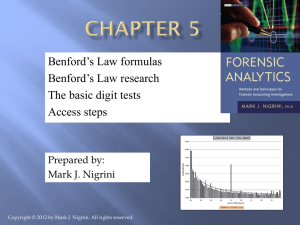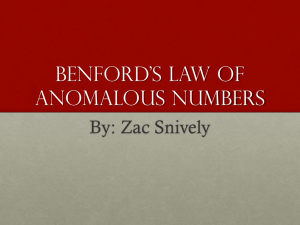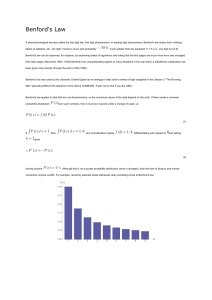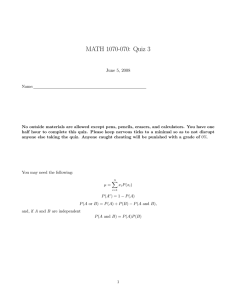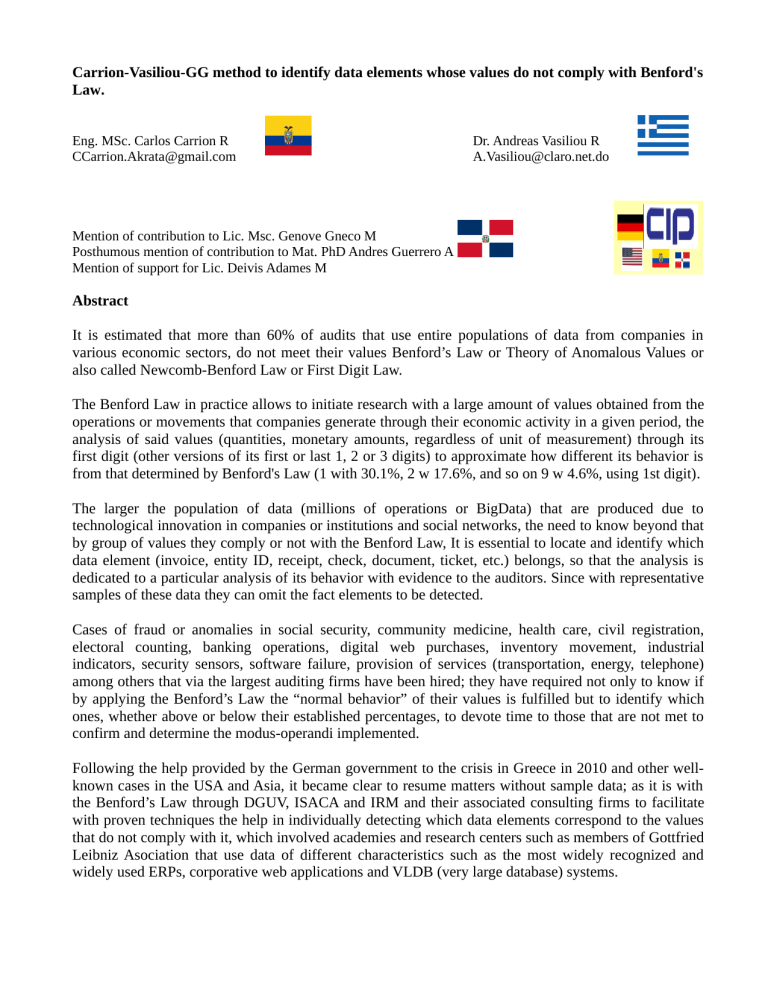
Carrion-Vasiliou-GG method to identify data elements whose values do not comply with Benford's Law. Eng. MSc. Carlos Carrion R CCarrion.Akrata@gmail.com Dr. Andreas Vasiliou R A.Vasiliou@claro.net.do Mention of contribution to Lic. Msc. Genove Gneco M Posthumous mention of contribution to Mat. PhD Andres Guerrero A Mention of support for Lic. Deivis Adames M Abstract It is estimated that more than 60% of audits that use entire populations of data from companies in various economic sectors, do not meet their values Benford’s Law or Theory of Anomalous Values or also called Newcomb-Benford Law or First Digit Law. The Benford Law in practice allows to initiate research with a large amount of values obtained from the operations or movements that companies generate through their economic activity in a given period, the analysis of said values (quantities, monetary amounts, regardless of unit of measurement) through its first digit (other versions of its first or last 1, 2 or 3 digits) to approximate how different its behavior is from that determined by Benford's Law (1 with 30.1%, 2 w 17.6%, and so on 9 w 4.6%, using 1st digit). The larger the population of data (millions of operations or BigData) that are produced due to technological innovation in companies or institutions and social networks, the need to know beyond that by group of values they comply or not with the Benford Law, It is essential to locate and identify which data element (invoice, entity ID, receipt, check, document, ticket, etc.) belongs, so that the analysis is dedicated to a particular analysis of its behavior with evidence to the auditors. Since with representative samples of these data they can omit the fact elements to be detected. Cases of fraud or anomalies in social security, community medicine, health care, civil registration, electoral counting, banking operations, digital web purchases, inventory movement, industrial indicators, security sensors, software failure, provision of services (transportation, energy, telephone) among others that via the largest auditing firms have been hired; they have required not only to know if by applying the Benford’s Law the “normal behavior” of their values is fulfilled but to identify which ones, whether above or below their established percentages, to devote time to those that are not met to confirm and determine the modus-operandi implemented. Following the help provided by the German government to the crisis in Greece in 2010 and other wellknown cases in the USA and Asia, it became clear to resume matters without sample data; as it is with the Benford’s Law through DGUV, ISACA and IRM and their associated consulting firms to facilitate with proven techniques the help in individually detecting which data elements correspond to the values that do not comply with it, which involved academies and research centers such as members of Gottfried Leibniz Asociation that use data of different characteristics such as the most widely recognized and widely used ERPs, corporative web applications and VLDB (very large database) systems. This methodology is based on adapting all the data with its main value (principle of important variables/components) that apply the Benford’s Law either in spreadsheet (if less than 1 million records, i.e. XLStat of MS Excel) or in statistical software such as R-system or Picalo / Python, to that of specified Dendrogram (Data Tree or Hierarchical Clustering) with its grouping method and metric corresponding to the nature of the data elements, managing to level the same differences (upper and lower) of Benford's Law, thus providing the position of the data whose value has been detected that does not comply with the described law in a list that is more manageable to analyze by the audit team. In various audit forums this methodology has been proposed and applied through consulting firms in the USA, Greece, Thailand, Syngapur, Brazil, Colombia, Germany, Austria, France, Russia, Sweden, Switzerland, Canada, Ecuador, Chile, Peru, Mexico, India and the Dominican Republic, the latter being confirmed in 2 electoral processes since 2012 and analyzing the civil registration of citizenship, confirmed these anomaly detections derived from the data provided by the systems platform used with consequences that even the BID and the US consulate had to act against directors in 2016. Like any methodology, that of Carrion-Vasiliou-GG, it had to pass several tests of its application in BigData, to reinforce the Benford’s Law to the auditors, based on the data of the institutions or companies that have corresponded to carry out research and analysis activities in several areas, which by their magnitude take the initial steps in a short term require. Always attentive to pose and demonstrate in the locality with the data that need to be analyzed with the CCVGG Carrion-Vasiliou-GG Method to complement the Theory of Anomalous Numbers or Benford’s Law and extend its practical application to the auditors who seek the continuous improvement of their activities, especially in countries where data samples are still using for investigations or reacting to the reception of complaints or claims. In memory of our advanced R-system instructor Mat. PhD Andres Guerrero Arias (deceased in Dec2014) that in 2009-2011 offered vast coverage of his mathematical models, and thanks to Lic. MSc. Genove Gneco Medina for his scholarly quantitative business management training and PICALO (aggravated his health in 2019), as well as the technical support of fellow auditor Lic. Deivis Adames, all of them from the Dominican Republic. Also thanking Dr. Andres Vasiliou R for his support and confidence in his ideas for the aspects of technology he has provided to this method through his research and contacts in European countries, USA and Asia. Keywords: Benford’s Law, Dendrogram, Quantitative Audit, Metric, Nature of Data Sources, Data Elements.
